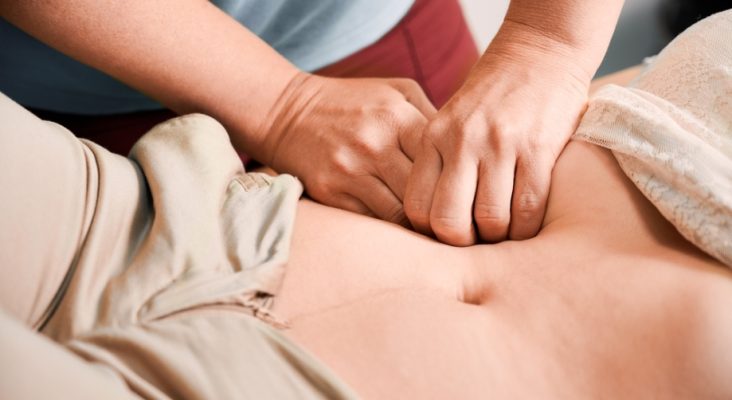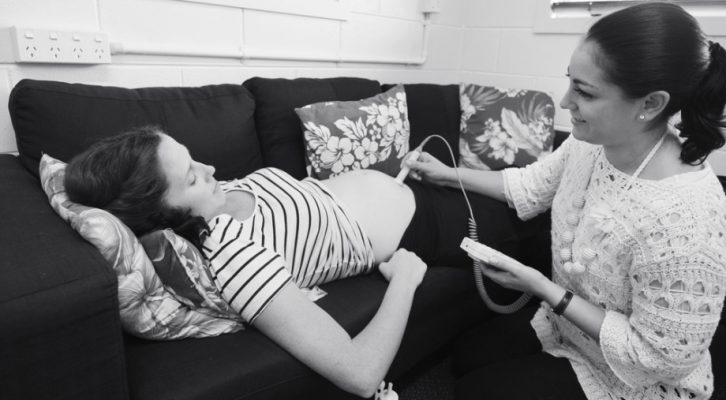
Abdominal Massage for babies (also called Belly Rub, Tummy Massage, Abdomen Massage, or Stomach Massage) is a popular treatment because it can give relief from gas, cramps, excessive crying, and colic, while promoting better sleep patterns. Another common aim of Infant Abdominal Massage is to improve the baby’s digestive health, that is, to positively stimulate or heal the Gastrointestinal Tract (GI Tract).
Babies – GI Tract System Development
The main components of the GI Tract system are the mouth, esophagus, stomach, liver, gallbladder, the pancreas, the large and small intestines, and anus.
When a baby is born, the GI Tract is not yet fully matured. This can give temporary adjustments or reactions of the GI Tract to food intake, which can show as diarrhea, vomiting, frequent burps, colic, irritability, skin rashes, excessive crying, bad sleeping patterns, abdominal pains, or cramps, and so on.

For instance, the so-called Digestive Lining in babies is still rather thin and immature, which puts them at higher risk of infections. The Digestive Lining is a layer of mucous that protects the GI Tract from microbes and other contaminants.
Certain enzymes that digest complex carbohydrates have not reached sufficient levels yet to digest more solid food, which can give abdominal pains if the baby starts to eat more solid food too early.
As some babies still don’t eat in a “controlled manner,” they often swallow too much air while eating, which can give problems of excessive air (gas) in the body and subsequent pains in the GI Tract. It may also be that they’re still oversensitive of gasses produced from the digested food.
Mind that the above mentioned issues are just some examples of the things that still need “to set” in the baby’s GI Tract; there are several more growth and development factors, but this was just to give you the idea of what “maturation” of the GI Tract can mean.
In any case, it’s only when an infant is about six to seven months old that its GI Tract system reaches a more mature development in which its able to digest more solid foods, while also being able to better combat possible harmful substances that entered the GI Tract. Although the GI system has then reached a much better adaption, it still needs several years, typically until the baby is about three years old, to mature more or less completely.
Abdomen Massage for Infants
Abdominal Massage for the infant’s digestive health aims at a healthy digestion by eliminating toxins (detoxification), obstructions, and tensions in the baby’s GI Tract.

This is mostly done by using massage techniques that promote overall blood circulation and lymphatic drainage, which in their turn can help to boost the immune system and better support the baby’s body to get rid of harmful substances, or of substances that were only needed while it was still in the womb.
It also aims at realigning and repositioning the internal organs in their proper place and giving them space for healthy mobility and functioning. Other health benefits of Abdominal Massage for the gastrointestinal tract are, for instance, relief of irritable bowel syndrome, heartburn, gastritis, bloating, colic, excessive gas, diarrhea, and constipation.
On an emotional level, “digestion” also symbolizes “emotional digestion,” that is, the ability to cope with emotional trauma. It’s thought that abdominal massages can help to digest physical and emotional trauma (for instance: neonatal birth trauma or other traumas that have occurred in the infant’s life), or can help to release unnecessary emotional residues and tensions bound in body tissues, such as in the abdominal muscles and internal organs.
Baby Abdominal Massage Techniques
An Abdominal Massage for babies is generally a gentle massage of the abdomen — often done with massage oils — applied with the palm of the hands and/or with the fingers. The baby usually lies on its back while receiving the massage.

The infant’s abdominal region is typically massaged by making small circular, clockwise movements with the (warm) hand palms or with the fingers. Generally, one starts around the navel, while simultaneously moving into a clockwise direction (the direction of one’s digestion and evacuation), spiraling out across the abdominal area to finally cover the complete abdomen.
Nevertheless, if the baby experiences excessive diarrhea, it may be better to massage in an anti-clockwise direction, but the opinions hereof vary.
Repeatedly bending the knees of the baby to the chest (either with both knees simultaneously or one knee after the other, like pedaling), or bringing the toes of the baby to the nose, can additionally help releasing excessive or obstructive gas more easily.
Massaging or gently pressing the abdominal area with warm herbal compresses (or alternatively: heated pads, warm water bags, etc.) can also give significant relief of abdominal pains and irritations, while profoundly stimulating the blood circulatory system.
A stand-alone Belly Rub for babies can be given at any time, notably when the baby experiences abdominal troubles, but it could also be more structurally incorporated in the baby’s life by giving it as part of a full body Baby Massage, two to three times per day, on set moments.
















